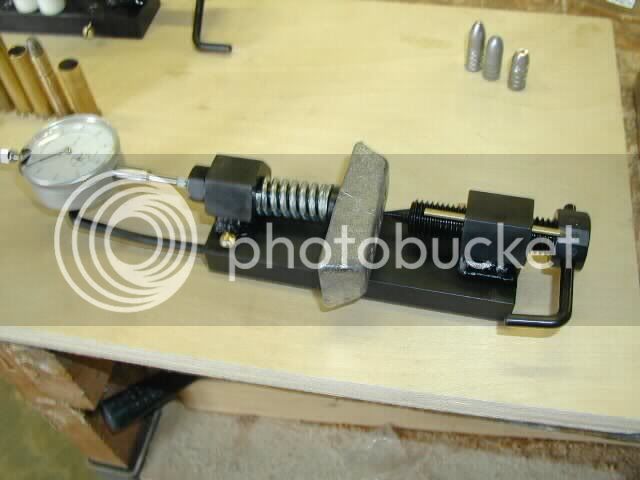Idaho Ron
58 Cal.
- Joined
- Mar 1, 2007
- Messages
- 2,729
- Reaction score
- 1,226
In the past I have reported lead hardness tests.
Since I had a couple of boxes of PRB's dug out I got to wondering what the hardness was on them.
I also did a couple of Maxi balls and Maxi hunters, and a couple of Hornady Great plains 410's. I used a cabin tree lead hardness tester. The cabin tree uses a dial indicator gage.

Pure lead is ranked 5 BHN. Wheel weights are ranked. 12.5 Lead shot is ranked 13 and lino type is 22 BHN. This info is given just to use as a reference nothing more. The readings on the dial leave a little space for interrupting the actual BHN.
Speer .495 PRB was .027 on the dial, about 2 to 3 BHN.
Hornady .490 PRB was .031 on the dial, a solid 3 maybe a bit more.
The TC maxi ball and the Maxi hunter were both the same in hardness. .024 on the dial,
about 2 BHN.
The Hornady Great plains bullet was .029,
about 2 maybe a pinch higher but under 3
I got a couple of ingots from a friend. From the stamp I am sure that these are plumbers lead. A while back I tried to contact a few local plumbing supply stores and the girls behind the counter said they didn't know what I was talking about. I gave up on trying to locate "new" plumbers lead and went with Rotometals for new lead. ANY WAY! The old plumbers ingots hardness. there were two 5 pound ingots.
#1 was .031 an that is a 3 BHN
#2 was .038 and that is about a 6 BHN
The interesting thing was the Speer balls. I got those about 10 years ago. Lead has a tendency to harden with age. As a new ball they must have been butter soft. The Hornady balls are about 2 years old. The bullets were all about to 4 years old. I have done tests on fresh poured lead and have seen the bullets from those fresh pours harden over a month or so. It was interesting to see where these older balls and bullets ended up as far as hardness. Ron
Since I had a couple of boxes of PRB's dug out I got to wondering what the hardness was on them.
I also did a couple of Maxi balls and Maxi hunters, and a couple of Hornady Great plains 410's. I used a cabin tree lead hardness tester. The cabin tree uses a dial indicator gage.

Pure lead is ranked 5 BHN. Wheel weights are ranked. 12.5 Lead shot is ranked 13 and lino type is 22 BHN. This info is given just to use as a reference nothing more. The readings on the dial leave a little space for interrupting the actual BHN.
Speer .495 PRB was .027 on the dial, about 2 to 3 BHN.
Hornady .490 PRB was .031 on the dial, a solid 3 maybe a bit more.
The TC maxi ball and the Maxi hunter were both the same in hardness. .024 on the dial,
about 2 BHN.
The Hornady Great plains bullet was .029,
about 2 maybe a pinch higher but under 3
I got a couple of ingots from a friend. From the stamp I am sure that these are plumbers lead. A while back I tried to contact a few local plumbing supply stores and the girls behind the counter said they didn't know what I was talking about. I gave up on trying to locate "new" plumbers lead and went with Rotometals for new lead. ANY WAY! The old plumbers ingots hardness. there were two 5 pound ingots.
#1 was .031 an that is a 3 BHN
#2 was .038 and that is about a 6 BHN
The interesting thing was the Speer balls. I got those about 10 years ago. Lead has a tendency to harden with age. As a new ball they must have been butter soft. The Hornady balls are about 2 years old. The bullets were all about to 4 years old. I have done tests on fresh poured lead and have seen the bullets from those fresh pours harden over a month or so. It was interesting to see where these older balls and bullets ended up as far as hardness. Ron





